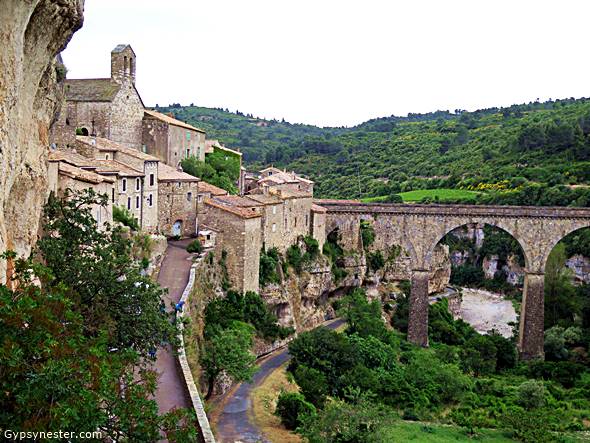
When we venture off the beaten path we often find that the most interesting places are tiny tucked away surprises that we, and almost everybody else it seems, have never heard of. Minerve is just such a place.
This southern French village is perched precariously atop a ridge between two rivers, le Brian and la Cesse, which have carved out cliffs that make the spot a nearly perfect stronghold. We must say nearly because we soon learned that it failed tragically under a relentless siege.
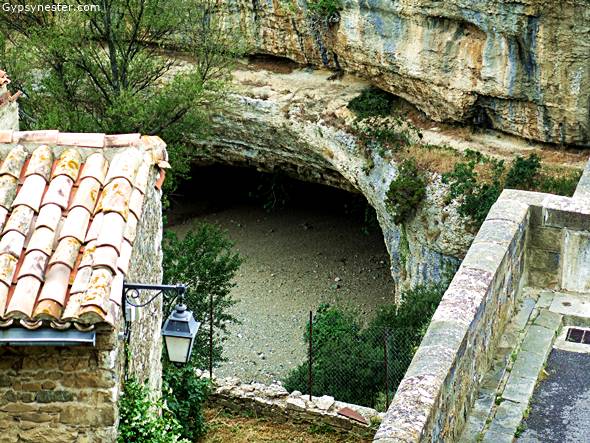 But before we found out about that failure we were wildly impressed with the fortifications. Most of the defenses are natural, left behind when water eroded the local limestone into a formidable castle-like formation that certainly looks impenetrable. With a little additional stone work the original inhabitants no doubt felt pretty safe a thousand years ago.
But before we found out about that failure we were wildly impressed with the fortifications. Most of the defenses are natural, left behind when water eroded the local limestone into a formidable castle-like formation that certainly looks impenetrable. With a little additional stone work the original inhabitants no doubt felt pretty safe a thousand years ago.
As we approached we marveled at the enormous bridge required to gain entry into the city, and the sheer walls that dropped away on every edge.
 Once inside, we were also thrilled by the fact that we had the narrow medieval lanes almost all to ourselves while we explored. It was about that time that Antoine, our guide for the barge cruise along the Canal du Midi that brought us here, pointed out that the street we were walking on was named Rue des Martyrs.
Once inside, we were also thrilled by the fact that we had the narrow medieval lanes almost all to ourselves while we explored. It was about that time that Antoine, our guide for the barge cruise along the Canal du Midi that brought us here, pointed out that the street we were walking on was named Rue des Martyrs.
That got us wondering what might have happened here. He didn’t explain until we arrived at a memorial to those martyrs.
At the small monument consisting of a Christian cross and the outline of a dove carved in a stone he began to relay the story of how, after several centuries of safety, the residents found that their security was fleeting. In 1210 the village fell at the hands of the Albigensian Crusade. The tale is one of the saddest we have heard throughout European history.
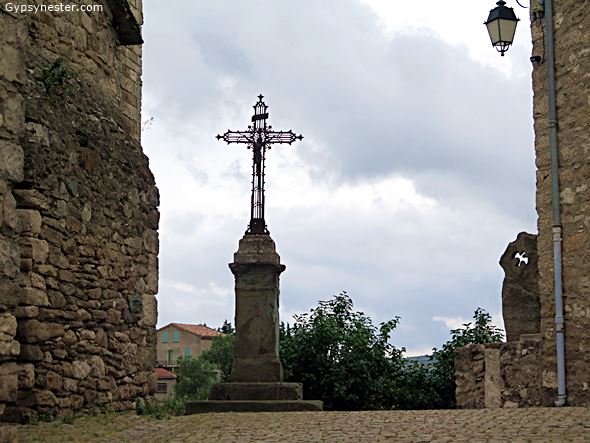
A relatively small religious sect, the Cathars, was living peacefully in this region when Pope Innocent III decided that he didn’t like their views and therefore they must be wiped clean off the planet. The Kingdom of France was more than happy to oblige in the extermination of the heritcs.
Their heresy mainly consisted of believing in two gods, a good and an evil, and worse yet, allowing women to have nearly equal standing in the church. Obviously it was imperative to eliminate every last one of them.
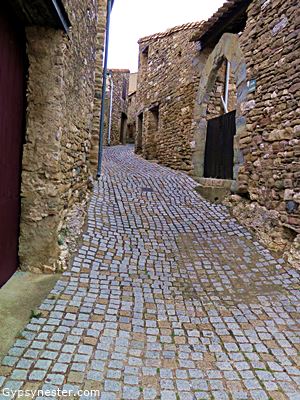 Once the Crusaders cleared the harmless Gnostics from the nearby cities of Béziers and Carcassonne the relentless zealots set their sights on Minerve. The town’s natural defenses held off a direct attack, so the invaders set up a siege.
Once the Crusaders cleared the harmless Gnostics from the nearby cities of Béziers and Carcassonne the relentless zealots set their sights on Minerve. The town’s natural defenses held off a direct attack, so the invaders set up a siege.
Catapults were placed on the opposite walls of the canyons surrounding the city and commenced firing. Several weeks of bombardment finally led to a surrender and the Cathars that lived in Minerve were given a choice, return to the Catholic faith or be put to death.
One hundred and forty refused the offer and were burned at the stake. This was at least slightly better than the crusaders had done in previous cities, there they simply killed everyone whether they were Cathars or not.
After hearing this tale while walking the path of the martyrs we ended up outside a small museum, the Musée Hurepel de Minerve. Stepping inside we encountered something completely unexpected, the entire history we had just discussed brought to life in remarkably meticulous miniature dioramas.
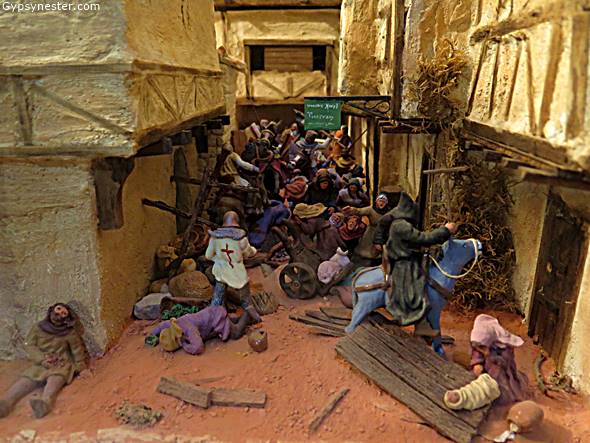 Each scene was accompanied by a detailed description in one of the booklets provided available in a dozen different languages. At first the whole set up struck us as very odd, even a bit off base for such serious subject matter, but within a few minutes we were completely engrossed and the story was forever imprinted in our memories.
Each scene was accompanied by a detailed description in one of the booklets provided available in a dozen different languages. At first the whole set up struck us as very odd, even a bit off base for such serious subject matter, but within a few minutes we were completely engrossed and the story was forever imprinted in our memories.
Feeling extremely somber by the time we left, we made our way back across the colossal bridge (vehicles are not allowed in the town unless owned by a resident) and began our trek back to the boat. Along the way we had one more stop to make.
Not far from Minerve, Antoine pulled off the highway onto a nearly nonexistent dirt road. We bounced a half a mile or so before stopping, then he jumped out and he led us up a small hill.
 At the top we found a few isolated megalithic burial stones, dolmens left behind by the Celts who lived here thousands of years ago, well before the time of Christ. These were kin to the people who made Stonehenge hundreds of miles to the north.
At the top we found a few isolated megalithic burial stones, dolmens left behind by the Celts who lived here thousands of years ago, well before the time of Christ. These were kin to the people who made Stonehenge hundreds of miles to the north.
Like the much larger and more famous archaeological marvel, this also lines up with the sun on the solstice. So while not as overwhelming, we were still duly impressed.
We were also glad to have this dose of celestial alignment help put the day’s earlier distressing history behind us.
David & Veronica, GypsyNester.com
See all of our previous adventures in France!
A big thank you to France Cruises for providing this adventure, as always, all opinions are our own.



What a great way to write, very interesting post.
Thanks!